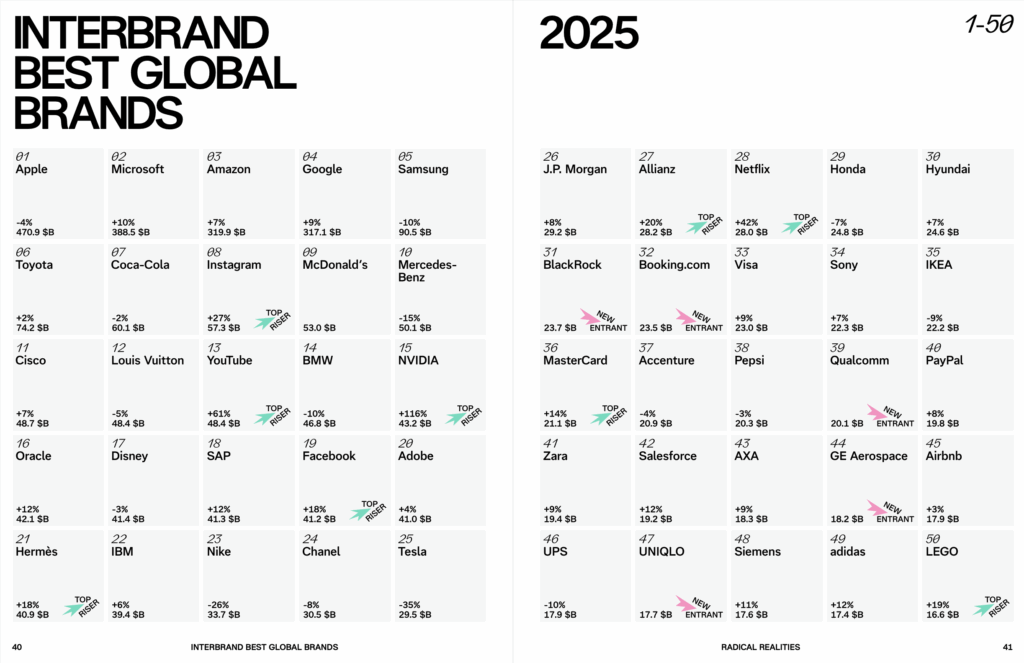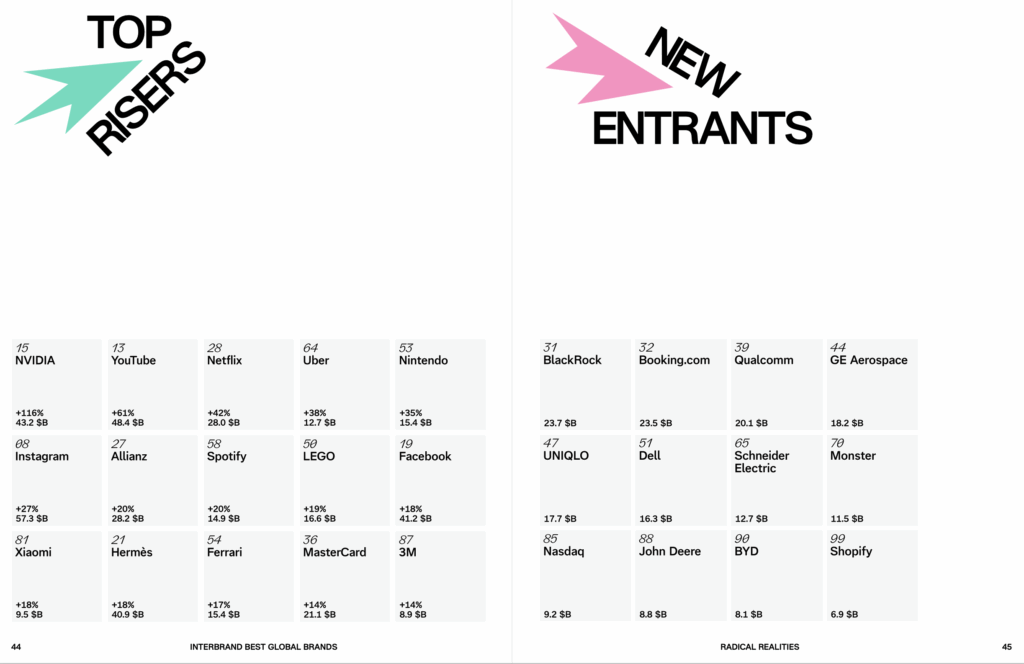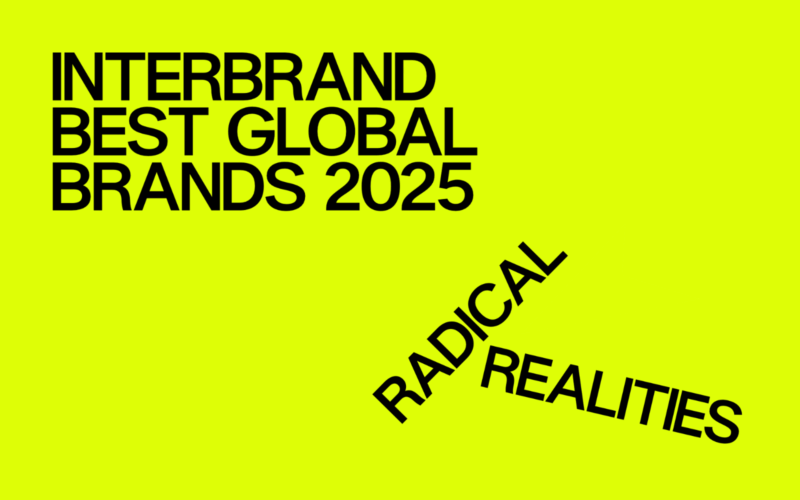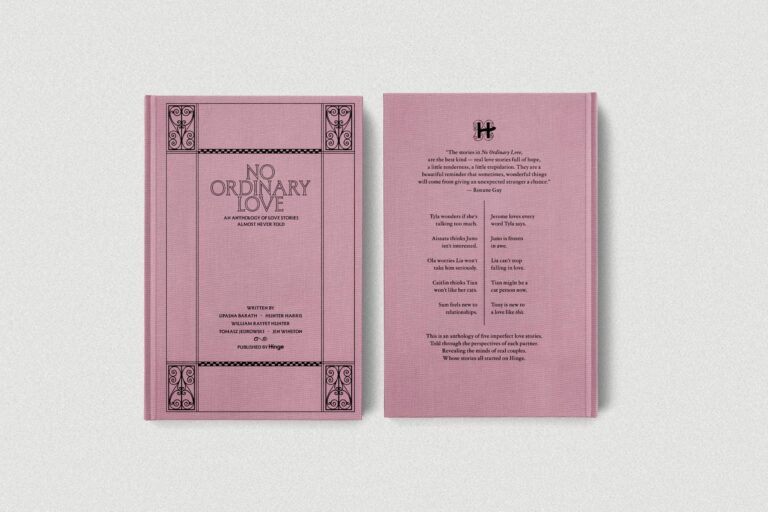Interbrand has just unveiled its Best Global Brands 2025 report, titled “Radical Realities“, revealing this year’s 100 most valuable brands and the forces reshaping the branding industry. As artificial intelligence transforms how people choose and how companies create value, the study marks a defining moment for global branding. One centered on staying indispensable in an age of intelligent (and artificial) intermediaries.
The combined value of the top 100 brands has climbed to US$3.6 trillion, up 4.4% from 2024. Yet beyond the numbers lies a clear message: the rules of brand growth are changing faster, and could completely redefine the customer decision process.
Below are our five key takeaways from Interbrand’s findings.
Please note that this article is independent of Interbrand and aims to share insights valuable to branding professionals worldwide.
Proven Systems for Business Owners, Marketers, and Agencies
→ Our mini-course helps you audit and refine an existing brand in 15 days, just 15 minutes a day.
→ The Ultimate Brand Building System is your step-by-step blueprint to building and scaling powerful brands from scratch.
Table of Contents
Which Brands Made It to the Top 25 List?
According to Interbrand, the top 25 most valuable brands in 2025 include Apple, Microsoft, and Amazon, which once again occupy the top three positions. They are followed by Google, Samsung, Toyota, Coca-Cola, Instagram, McDonald’s, and Mercedes-Benz, rounding out the top ten. The rest of the top 25 includes Cisco, Louis Vuitton, YouTube, BMW, NVIDIA, Oracle, Disney, SAP, Facebook, Adobe, Hermès, IBM, Nike, Chanel, and Tesla. This mix highlights the continued dominance of tech, luxury, and experience-driven brands.

The report also highlights the brands to watch, the fast risers, as well as the new entrants to the ranking.

NVIDIA recorded a staggering +116 % surge in brand value, the largest in the ranking’s 25-year history. YouTube (+61 %), Netflix (+42 %), Uber (+38 %), Nintendo (+35%), and Instagram (+27 %) also made dramatic gains in brand value, illustrating how brands that integrate into everyday digital behavior continue to dominate.
Insight #1: AI Agents Are Replacing Traditional Customer Journeys
There is a shift toward agentic commerce, where AI assistants act on behalf of consumers. Instead of browsing websites, reading reviews, or comparing products, people can ask an AI to handle the purchase for them.
In practical terms, it works like this:
- A consumer asks the AI a question or makes a request. For example, “Find a birthday gift for my friend who likes photography.”
- The AI interprets the request, searches multiple sources, compares options, and evaluates prices.
- The AI completes the transaction through Shopify (or another platform) without the user ever leaving the conversation.
This has profound implications for brands:
- Traditional touchpoints vanish: websites, store visits, reviews, and social media interactions are bypassed.
- Brand messaging loses control: the AI may present or summarize products in ways the brand doesn’t directly influence.
- Algorithms become the primary influence: what the consumer sees and ultimately chooses is largely determined by AI reasoning and ranking, not marketing campaigns.
In short, AI shifts the power of influence away from brands toward the agent, compressing the customer journey from hours or days of exploration into seconds. And because branding has always focused on influencing the customer decision process, this has a profound impact on how future brand strategies will be developed.
Insight #2: AI Won’t Erase Brands, but Only Some Will Drive Decisions
As we’ve seen above, agents driven by artificial intelligence will make decisions on behalf of people and consumers. This will completely redefine how brands thrive globally. Brands aren’t disappearing, and many names and logos will remain. Yet, only a few will be able to truly influence what people decide.
“AI is already changing our exploration and understanding of reality – and, therefore, our choices. While brands do not face an imminent risk of extinction, they do face the prospect of accelerated selection. There will still be many names, logos and labels out there – but in time, fewer will be truly capable of influencing human choice.”
Insight #3: The New Branding Challenge Is to Win Over Both Bots and People
In this new AI reality, brands now face a choice:
- They can focus on appealing to bots, optimizing for generative AI and algorithms to win in search results and automated recommendations.
- Or, they can focus on connecting with humans, shaping perceptions and building loyalty, becoming “masters of their own destiny” instead of letting algorithms control their future.
The strongest companies will do both: design for bots to stay visible, while building connections to influence real human choice. Putting all the focus on bots leaves brands at the mercy of algorithms, with little control over growth or reputation.
“The rewards of designing and deploying content and communication for a range of AI agents can be massive – and fast. However, focusing on these gains alone comes with a significant risk – a brand’s disappearance from the radar of customer choice, and a subsequent commercial dependence on artificial intelligences governed by third parties.”
Insight #4: Deep Human Meaning and Connection: The New Survival Skill for Brands
As AI helps us make more buying decisions, only brands that truly matter to us will stay important. If a brand isn’t special or meaningful, it risks being replaced by whatever the AI picks as the best deal. Brands that connect deeply with us personally and emotionally are the ones we’ll still choose ourselves.
The 2025 report argues that in the age of AI and “agentic commerce,” visibility no longer guarantees choice. As consumers increasingly delegate decisions to algorithms, the ability of a brand to remain top-of-mind, depends on its perceived indispensability.
The key measure here is Interbrand’s Role of Brand Index (RBI), which quantifies how much of a purchase decision is driven by the brand itself rather than by price, features, or convenience.
A 1 % rise in RBI correlates, on average, with a 2.3 % increase in share price, making it one of the most predictive brand metrics of business performance.
“If your brand isn’t indispensable,” the report warns, “it’s likely to become disposable.”
Insight #5: Brands That “Do One Thing Well” Are Thriving
The brands climbing fastest in 2025 tend to share a defining trait: focus. They are addressing an unmet human need, then use that focus as a platform to expand across new categories and arenas.
For example, NVIDIA is redefining computing, Booking.com simplifies exploration, UNIQLO elevates everyday wear, and Shopify empowers entrepreneurs at scale.
The next frontier of brand growth will be defined not by what companies make, but by the meaning they create.
Conclusion: From Brand Management to Brand Meaning
The 2025 Best Global Brands study makes one truth abundantly clear: the age of AI does not eliminate the need for branding, it redefines it.
Brands now operate in an ecosystem where algorithms influence decisions, expectations evolve daily, and human attention is both scarce and priceless. Amid this complexity, the most successful brands are those that remain meaningful, focused, and human.
In other words, the future belongs to brands that are chosen not because they are convenient, but because they are indispensable.
Link to the full report: Interbrand’s 2025 Top 100 Best Global Brands Report









